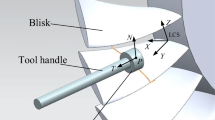Abstract
Robot hands grasp parallel groove clamps in assembly operations. The locations of parts during assembly are very important in grasping planning. Directly measuring the locations of all parts in the assembly process is tedious. A motion simulation is proposed to calculate the locations of parts in the assembly process. The boundary representation method describes the geometric information of the part. Assembly sequences simplify the movements of parts. Concave-arc surface collision detection is proposed to calculate the locations of irregular concave parts. The proposed method is found to be computationally less expensive than the collision detection method based on meshing. This research provides a foundation for further studies of robot hand manipulation in irregular assemblies.













Similar content being viewed by others
Availability of data and materials
All data generated or analyzed during this study are included in this published article.
References
Nagarajan B, Li Y, Sun ZY, Qin RW (2019) A routing algorithm for inspecting grid transmission system using suspended robot: enhancing cost-effective and energy efficient infrastructure maintenance. J Clean Prod 219:622–638. https://doi.org/10.1016/j.jclepro.2019.02.088
Nguyen VN, Jenssen R, Roverso D (2018) Automatic autonomous vision-based power line inspection: a review of current status and the potential role of deep learning. Int J Elec Power 99:107–120. https://doi.org/10.1016/j.ijepes.2017.12.016
Qin LJ, Wang T, Yao C (2018) Research on application of location technology in 3D virtual environment modeling system for substation switch indicator. Intell Autom Soft Co 24:115–121. https://doi.org/10.1080/10798587.2016.1267250
Tu JC, Qian XM, Lou PH (2017) Application research on AGV case: automated electricity meter verification shop floor. Ind Robot 44:491–500. https://doi.org/10.1108/IR-11-2016-0285
Cohen J (1987) Live-line repair with Tomcat Epri J 5:14–19
Aracil R, Ferre M, Hernando M, Pinto E, Sebastian JM (2002) Telerobotic system for live-power line maintenance: ROBTET. Control Eng Pract 10:1271–1281. https://doi.org/10.1016/S0967-0661(02)00182-X
Suarez-Ruiz F, Zhou X, Pham QC (2018) Can robots assemble an IKEA chair? Sci Robot 3:eaat6385. https://doi.org/10.1126/scirobotics.aat6385
Liu CH, Chen TL, Chiu CH, Hsu MC, Chen Y, Pai TY, Peng WG, Chiang YP (2018) Optimal design of a soft robotic gripper for grasping unknown objects. Soft Robot 5:452–465. https://doi.org/10.1089/soro.2017.0121
Babin V, St-Onge D, Gosselin C (2019) Stable and repeatable grasping of flat objects on hard surfaces using passive and epicyclic mechanisms. Robot Cim-Int Manuf 55:1–10. https://doi.org/10.1016/j.rcim.2018.06.002
Van-Wyk K, Culleton M, Falco J, Kelly K (2018) Comparative peg-in-hole testing of a force-based manipulation controlled robotic hand. Ieee T Robot 34:542–549. https://doi.org/10.1109/TRO.2018.2791591
Power-Lines E (2009) IEEE guide for maintenance methods on energized power-lines. Ieee Standard 516. https://doi.org/10.1109/IEEESTD.2009.5137335
Dogar M, Spielberg A, Baker S, Rus D (2019) Multi-robot grasp planning for sequential assembly operations. Auton Robot 43:649–664. https://doi.org/10.1007/s10514-018-9748-z
Murali GB, Deepak BBVL, Raju MVA, Biswal BB (2019) Optimal robotic assembly sequence planning using stability graph through stable assembly subset identification. Proc Inst Mech Eng C J Mech 233:5410–5430. https://doi.org/10.1177/0954406219842908
Luo L, Mo J, Yang X (2018) A method of using image-view pairs to represent complex 3D objects. Cogent Eng 5:1–18. https://doi.org/10.1080/23311916.2018.1491264
Choi AR, Kim SM, Sung MY (2017) Controlling the contact levels of details for fast and precise haptic collision detection. Front Inform Tech El 18:1117–1130. https://doi.org/10.1631/FITEE.1500498
Wang TT, Tang M, Wang ZD, Tong RF (2018) Accurate self-collision detection using enhanced dual-cone method. Comput Graph-UK 73:70–79. https://doi.org/10.1016/j.cag.2018.04.001
Caplan PC, Haimes R, Darmofal DL, Galbraith MC (2020) Four-dimensional anisotropic mesh adaptation. Comput Aided Des 129:102915. https://doi.org/10.1016/j.cad.2020.102915
Meng QX, Wang HL, Cai M, Xu WY, Zhuang XY, Rabczuk T (2020) Three-dimensional mesoscale computational modeling of soil-rock mixtures with concave particles. Eng Geol 277:105802. https://doi.org/10.1016/j.enggeo.2020.105802
Adan DH, Cardos R (2020) Quasi-isotropic initial triangulation of NURBS surfaces. Eur J Comput Mech 29:27–82. https://doi.org/10.13052/ejcm2642-2085.2912
Lee SY (2015) Polyhedral mesh generation and a treatise on concave geometrical edges 124:174–186. https://doi.org/10.1016/j.proeng.2015.10.131
Thomas F, Torras C (1994) Interference detection between non-convex polyhedra revisited with a practical aim. Proceedings of the 1994 IEEE International Conference on Robotics and Automation, pp 587–594. https://doi.org/10.1109/ROBOT.1994.351236
Tu CH, Wang WP, Mourrain B, Wang JY (2009) Using signature sequences to classify intersection curves of two quadrics. Comput Aided Geom Des 26:317–335. https://doi.org/10.1016/j.cagd.2008.08.004
Brozos-Vázquez M, Pereira-Sáez MJ, Souto-Salorio MJ, Tarrío-Tobar AD (2019) Classification of the relative positions between a small ellipsoid and an elliptic paraboloid. Comput Aided Geom Des 72:34–48. https://doi.org/10.1016/j.cagd.2019.05.002
Brozos-Vázquez M, Pereira-Sáez MJ, Souto-Salorio MJ, Tarrío-Tobar AD (2018) Classification of the relative positions between a circular hyperboloid of one sheet and a sphere. Math Method Appl Sci 41:5274–5292. https://doi.org/10.1002/mma.5079
Jia XH, Tu CH, Mourrain B, Wang WP (2020) Complete classification and efficient determination of arrangements formed by two ellipsoids. Acm T Graphic 39:1–12. https://doi.org/10.1145/3388540
Kwon S, Mun D, Kim BC, Han S, Suh HW (2019) B-rep model simplification using selective and iterative volume decomposition to obtain finer multi-resolution models. Comput Aided Des 112:23–34. https://doi.org/10.1016/j.cad.2019.03.003
Weiler K (1985) Edge-based data structures for solid modeling in curved-surface environments. Ieee Comput Graph 5:21–40. https://doi.org/10.1109/MCG.1985.276271
Meisters GH (1975) Polygons have ears. Am Math Mon 82:648–651. https://doi.org/10.1080/00029890.1975.11993898
Funding
This work was supported by the National Natural Science Foundation of China (NSFC; grant number U1813216).
Author information
Authors and Affiliations
Contributions
Xin Shi was in charge of investigation, validation, resources, project administration, supervision, and funding acquisition. Li Tian was in charge of conceptualization, investigation, methodology, validation, and writing the original draft.
Corresponding author
Ethics declarations
Ethical approval
This work is in compliance with the ethical standards.
Consent to participate
No applicable.
Consent for publication
The manuscript has been approved for publication by all authors.
Competing interests
The authors declare no competing interests.
Additional information
Publisher's note
Springer Nature remains neutral with regard to jurisdictional claims in published maps and institutional affiliations.
Rights and permissions
About this article
Cite this article
Shi, X., Tian, L. Towards robotic assembly: collision detection between each part of the parallel groove clamp. Int J Adv Manuf Technol 119, 4349–4358 (2022). https://doi.org/10.1007/s00170-021-08484-3
Received:
Accepted:
Published:
Issue Date:
DOI: https://doi.org/10.1007/s00170-021-08484-3




